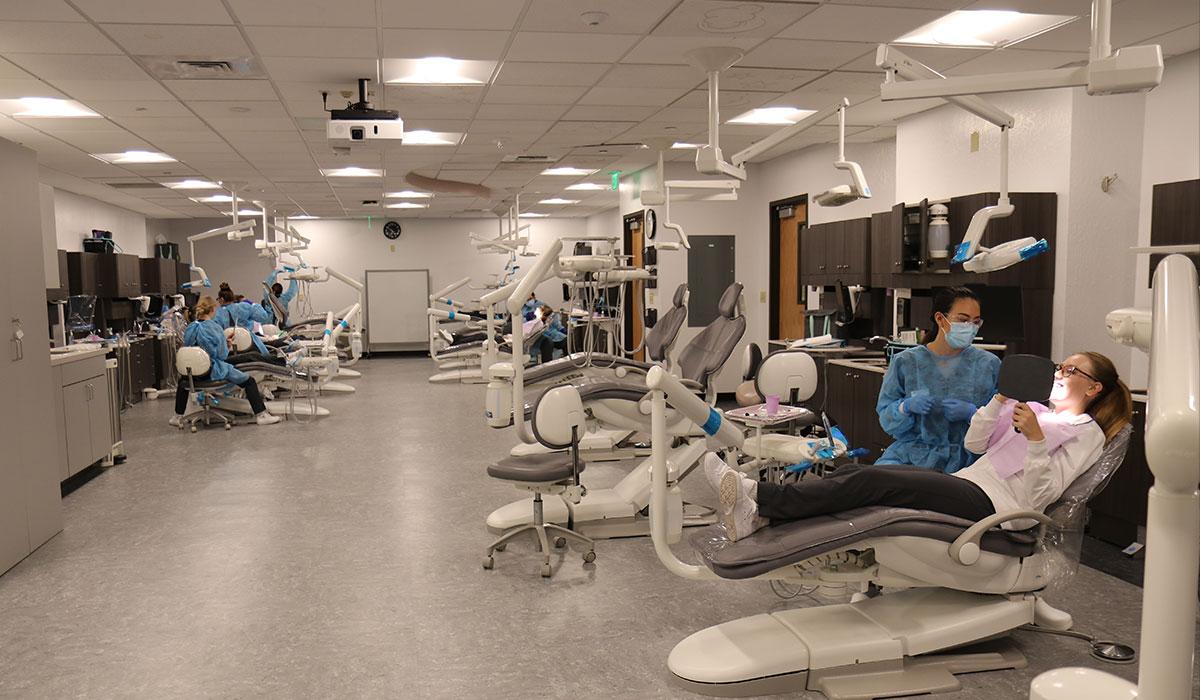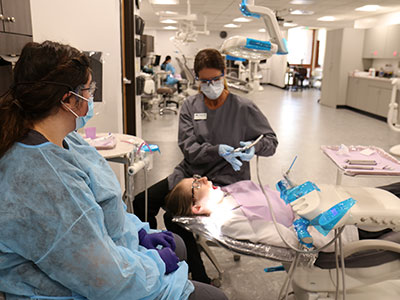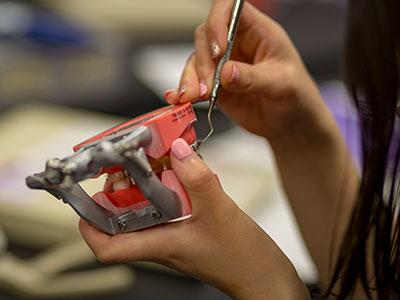
On June 1, students in the Dental Hygiene and Dental Assisting Programs returned to a newly renovated clinical space that, thanks to a $1.6 million dollar grant from the William N. Pennington Foundation, is opening many opportunities. For now, students will resume their hands-on clinical hours that were interrupted by the move to remote learning that occurred right before spring break.
“These next two weeks we’re finishing up the labs and the first few weeks of June we are bringing patients back, but it’s under very strict protocols and measures that all follow CDC and OSHA guidelines,” said Lori McDonald, Director of the Dental Hygiene Program. “It’s almost like a pilot course, so we can see what works and what doesn’t work for Fall. I feel blessed to be back in here—as in any of the allied health fields, students cannot complete their skills and requirements online.”
Dental hygiene students who are returning to the lab will start with an eight-hour lesson on how to administer anesthesia properly, one of the many hands-on lessons that cannot be completed remotely. Dental assisting, on the other hand, will prepare its students for “rotations” in local dental offices.
“We are waiting on personal protective equipment (PPE) for them,” said Dental Assisting Program Director Julie Muhle, who has been fielding calls from local dental offices who are asking for TMCC dental assisting students so they can complete their program by July. If everything goes according to plan, students in the Dental Hygiene Program will be complete by the end of June, pending a decision from the regional dental board regarding their final board exams.
It is a question that is invited, in part, by the new clinical space and the potential of what this can offer to students. No longer does it simply house cabinets and chairs; thanks to the support of the Pennington Foundation and several local dentists, there are many new opportunities for TMCC students in the Dental Hygiene and Dental Assisting Programs.
Support from the Pennington Foundation
The William N. Pennington Foundation has been a longtime supporter of the Dental Assisting and Hygiene Programs. “They understand that things evolve,” said Muhle. “Lori and I are always looking to the future—looking at trends—because there are so many changes in all aspects of health care. That’s what’s so great about Pennington… they understand that things evolve and what works great today may not be the best way to meet our students’ and community’s needs tomorrow.”
In 2013, the Pennington Foundation awarded both programs a $300,000 grant to make changes in the lab located in Red Mountain 414. “That allowed us to add two additional chairs and two new x-ray rooms,” said Muhle, who said the growing need in both programs had led to scheduling bottlenecks. “Dental Hygiene was adding students, and Dental Assisting was adding students as well. Plus, our student demographic had drastically changed. It used to be that students in these programs lived at home, and they didn’t work. Today, our students are working as well as attending classes, so we need to be respectful of their week and evening time.”
In 2017, the Adopt-A-Vet program began sharing the clinical space, which inspired new ideas about how to expand the dental programs. “We realized we could have a separate clinical area where we could possibly have a faculty practice area down the road, because when hygiene sees patients, we realize a lot of them need restorative care. However, a lot of them might not have access to funds or a place to do that restorative care. So… all of this really started with Pennington recognizing our need in 2013, and helping us financially with that. These [more recent] renovations are the second phase of that,” said Muhle.
The grant from the Pennington Foundation provided equipment and renovations to the separate clinic currently used by Adopt-A-Vet, an organization that provides military veterans who do not qualify for veteran dental benefits free oral care.

Renovations to the dental clinic have given dental assisting and dental hygiene students a realistic work environment.
Other renovations to the main dental clinic include the addition of two more dental chairs, bringing the total number of chairs in the dental clinic to 14. The clinical space also received several upgrades that turned the space from an approximation of a dental clinic into what students will find in any professional working space. “Our clinic before was not set up for either hygiene or dental assisting, and it didn’t function as you would find in any [working] dental facility. We just had to pretend things, and now...it’s an authentic work situation. So they can slide right into those offices knowing how to use this equipment and having things placed where they are supposed to,” said Muhle. Additionally, renovations increased the number of radiology rooms from six to ten (nine are fully functional. The tenth will be ready by the Fall semester.) These upgrades will significantly impact both programs.
“Every year there are always people who apply to the Dental Assisting Program who don’t get in,” said Muhle, who admits that she’s had seventy applicants for 24 spots. “Many of these applicants don’t have any general education credits yet. This renovation will allow us to start our basic training, entry-level dental assisting classes. This new program [which launches in the summer of 2021] will help folks who have absolutely no general education credits to ‘get their foot in the door.’ In three courses, these students could earn their certificate as a Sterilization Technician (which has been in really high demand in the past few years), as well as a Certificate of Completion.”
The number of opportunities that have been made possible because of these renovations are many; and both McDonald and Muhle half-joke that before long, both programs will take over the fourth floor of the Red Mountain Building. “This expansion is opening up doors to have our entry-level dental assisting students, for us to be able to take more students, and there are so many more areas of dental assisting and hygiene now. You know, down the road, we might have expanded functions for dental assisting or hygiene,” said Muhle, who notes that dental assisting and dental hygiene are two professions that will not be replaced by automation any time soon.
“You just can’t [automate] what we do as dental professionals. It’s a very hands-on profession, and requires hand-eye-skill coordination. I mean, you can’t have that plus also being able to be compassionate to the patient’s needs,” said McDonald. “That’s a big part of our job, right? Taking care and helping, but also making sure that the patient is comfortable so they can receive the oral care they need.”
It’s a profession that dentists and the public cannot live without. In fact, in the early 1990s, Reno and Sparks witnessed what happened when the demand for dental hygienists was high, and there were no professionals to be found.
Dental Hygiene at TMCC: How It All Began
Reno Dentist Dr. Gene Pascucci has been a longtime supporter of TMCC’s Dental Hygiene Program, so perhaps it’s no surprise that he has continued to garner community support that has enabled graduates to pursue careers in dental hygiene in Northern Nevada and beyond. “He’s been our champion, out there trying to let the dentists in the community know our needs,” said McDonald. “He even got support from the Lee F. Del Grande Foundation to help fund new technology for our dental chairs. We’re very blessed and we’re very grateful for him.”
Dr. Pascucci remembers the days before TMCC’s Dental Hygiene Program. As one of many local dentists with private practices, times were vastly different in the late 1980s and early 1990s. “We just couldn’t find hygienists... so many of us were ‘stealing’ them from one another,” said Pascucci. (As Muhle remembers: “Back then, they said the requirement for hiring a hygienist was a pulse.”)
This was far from an ideal—or even workable—solution, so he and another local dentist, Dr. William Wager, brainstormed one night on possible solutions. The brainstorming resulted in a letter that Pascucci sent to Dr. Ray Rawson, a Nevada Senator and dentist who was instrumental in starting the dental school at UNLV. The letter asked Rawson how many students from Northern Nevada had been admitted to the dental hygiene programs in the southern part of the state. The response? They hadn’t accepted a single student from the northern part of the state for five years.
It was clear that there was a need for a program; the question, of course, was how to fund it. Pascucci approached both UNR and TMCC with the idea of starting a program in Dental Hygiene. “TMCC [greeted the idea] with open arms,” said Pascucci. “I love TMCC, they have always been so community-oriented.”
This is what prompted Pascucci’s “crazy plane ride” in inclement weather to a Board of Regents meeting that was happening in Elko, Nevada. The Board of Regents said they would vote for the Dental Hygiene program, but that the question of funding would need to be sorted out. What followed was a five-year journey in which Pascucci advocated with local community support for this new program.
“We phone-canvassed the community of dentists,” he remembered. “Everyone donated at least $1,000.”
“Dr. Pascucci fired up those [local] dentists, they provided over $50,000. There were so many that contributed,” remembered Muhle. That was the year 2000. The rest, Pascucci said, was like the movie A Field of Dreams.
“Build it and they will come… some amazing faculty and staff got the program up and running. And once it was, the program was one of the top-rated ones in the country,” said Pascucci, who continues to support and advocate for the dental programs at TMCC.
“The dentists have donated money [for the most recent renovations],” said Muhle. “Even during this time when things are crazy, they’ve been donating for over a year now. It’s added up, and we’ve been able to buy radiology mannequins and digital sensors. We are so grateful for all the support from our local community.”
Renovations to Meet the Needs of this Dynamic Career Field

The skills that dental assistants and dental hygiene offer cannot be automated and are in high demand.
Dental assisting and hygiene are professions that are rapidly changing with what we are learning we need for our oral health. Once, these professions were confined to working in private practices and dentist offices; however, that is no longer the case. “Now we’re in public health, in urban areas, rural areas; we’re in hospitals and care facilities and places that we’ve never been before,” said Muhle. In other words, the need for these kinds of allied health professionals has never been greater.
The new clinical space is also moving students more quickly into the digital technology available to hygienists and assistants in most professional settings. “We still have to teach the traditional theory and methodology because that’s a part of the curriculum requirements through the Commission on Dental Accreditation (CODA) our accrediting body, but making our students marketable is really important,” said Muhle.
In addition to having the chairside computers, and the opportunity to work with the software used in dentistry before entering the workplace, dentists also requested that students be trained on digital radiography. “We’re still a few sensors short, but… we can now train students on that, because the learning curve [on that technology] can take a minute, so they like that our students will be familiar with that when they are hired,” said Muhle.
What is clear is that the demand for professionals in dental assisting and dental hygiene is as strong as ever. Forty students applied to the dental hygiene program, which only offers 14 spots to each graduating class. “I still get calls and emails from dentists saying that they need hygienists and assistants,” said McDonald. “The need and demand for both professions is certainly there.”
Thank You to Donors
In addition to the generous grant by the William N. Pennington Foundation, there were several donors who helped to make these renovations to the dental clinic a reality. The Robert Z. Hawkins Foundation, the Lee F. Del Grande Foundation, the Dorothy Towne Foundation and the E.L. Cord Foundation also contributed to this effort.
Local dentists who contributed to the recent renovations include:
- John Aramini
- Robert Crouse
- John C. Digrazia
- Gregory R. Eissmann
- Michael Herrera
- Jeremy M. Keener, DDS
- Justin Kiggins
- Kenneth E. Lang
- Steven Morgan
- Morrey Distributing Co.
- Daniel F. Muff
- James R. Muff
- Maurice Palermo
- Mary Papez-Berg
- Gene Pascucci
- Gregory J. Pisani
- Arnold Pitts
- William R. Platt
- Reno Dentures, LLC
- Mark Rosenberg
- Logan Smith
- Sierra Nevada Periodontics & Implant Dentistry
- Sparks Family Dentistry, LLC
- George A. Zatarain
Lori Benvin, executive director, Northern Nevada Dental Society, was also integral to the fundraising efforts for the dental clinic renovations. She reached out to the members of the Northern NV Dental Society by email to solicit donations.
Three dentists signed the appeal letter that helped to champion the effort, led by Dr. Pascucci:
- Dr. Gene Pascucci
- Dr. Greg Pisani
- Dr. Kenneth Lang
For more information about TMCC’s Dental Hygiene Program, contact the department at 775-673-8247. For more information about TMCC’s Dental Assisting Program, contact the department at 775-673-7125.






